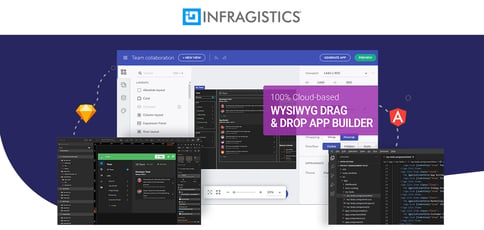
TL; DR: Infragistics delivers frameworks to support drag-and-drop coding simplicity for web and app design, user experience, and business intelligence. Its tools simplify the development process to reduce resource requirements and speed up time to market for most business use cases. Infragistics continues to adapt to the competitive and fast-paced market and to improve its site-building frameworks and other innovations to keep up with shifting market needs.
Visual coding programs and drag-and-drop coding tools offer different user experiences — even if the results are the same. A visual coding program functions like a script in which users drag elements into a sequence, tweak them, and then run it.
A drag-and-drop coding tool uses a visual environment — rather than a text-based interface — to develop an application, with the backend engine converting visual features into code.
The team at Infragistics understands that difference and set out to build sophisticated visual coding software that was as easy to use as a drag-and-drop version.
“Back in the 1990’s, we wrote tools so developers could visually design their menus and screens, connect to databases, and generate C code,” said Dean Guida, CEO of Infragistics. “One of our capabilities, which no one else was offering at the time, was providing a WYSIWYG environment that allows developers to design their whole application and then generate code.”

Over the years, Infragistics expanded to support companies in the finance, insurance, government, and manufacturing sectors. Those include enterprises that command significant market share in their industries. But the company’s core products are priced on a per-developer basis, so even small boutique firms or SMBs can benefit from the Infragistics toolkit.
Infragistics delivers a comprehensive suite of products aligned to four broad business objectives: design and development, UX, business intelligence, and team productivity. Its design portfolio is optimized for web, mobile, and desktop app development. The company puts drag-and-drop tools on top of common coding frameworks to speed up development for teams building mobile or business apps for the web.
The UX portfolio includes a cloud-based WYSIWYG app builder with a complete design-to-code system, as well as prototyping, user testing, and design and development collaboration in a single digital product design platform. Its digital collaboration offering, called Slingshot which is a digital workplace that connects everyone you work with to data analytics—organizes projects, content and chats—to boost team results.
“Over 30 years later, Infragistics continues to differentiate itself through innovative UX/UI, low-code collaboration, data visualization, and productivity tools,” Dean said.
Coding Languages and Visual Tools Evolve Over Time
A macro in Microsoft Excel is a simple example of the visual coding phenomenon. Still, a more complex version lies with data science tools like Knime, which use visual flow paths to ingest, modify, and display complex data sets.
The output for a drag-and-drop version is typically a stand-alone, multifunctional program rather than a script that performs a single task.
Infragistics’ had many years of success in the Java UI component markets with enterprise systems built at Charles Schwab trading system and FedEx shipping application to name a few. After the dot com bubble blew up and the recession, Sun Microsystems repositioned Java into more of a backend language. After that, Infragistics leaned on a relationship with Microsoft to advance its vision.
“We had licensed our UI Visual Basic Components to Microsoft, and they included these components in the first version of Visual Basic,” Dean said. “Microsoft was impressed enough with the tools that when they announced the early alpha version of .NET program, Microsoft chose Infragistics along with four other software developers to be on stage at the Microsoft Professional Developer Conference. That was a big boost for the Infragistics team.”

Visual coding tools face a dual challenge because they must continuously improve the logic of the design-to-code algorithms and keep pace with changes in the coding languages they support.
“We anticipate and embrace change quickly,” Dean said. “We rebuild our software ahead of each technology shift. For example, Microsoft moved to the web and open-source space aggressively over the last five years and created a new software framework for building web applications called Blazor. Infragistics worked closely with Microsoft to build a library of professionally designed UI components for C# and .NET developers using Blazor.”
Visual Site Building Can Save Significant Time and Money
Many tech-savvy coders prefer to work with text editors, but that development approach may be slower and prone to more errors. Although a competent coding team can be highly efficient, AI-generated code can more accurately reflect a visual developer’s intent and generate clean error-free code on the first pass.

products save businesses time and money.
For SMBs, the savings in bug fixing, code drafting, and prototyping is likely to far outweigh the potential loss for most typical web, mobile, and desktop apps. That approach can also help site builders reduce, if not avoid, the need for extensive prototyping.
“With our software, companies that had been coding a project for hours could turn them around in minutes,” Dean said. “Our software has already saved countless hours of work for our customers. For example, we had a very robust UI toolset for subscription and charged $1,000 a year for that subscription. Our competitors were selling only half of the UI component value for $1,000 to $1,500. And they weren’t shipping as fast as we were.”
Rapid deployment of web tech can fuel significant market advantages, particularly related to incorporating new tools or functionalities. If Microsoft were to release a new API for OneDrive file access to iOS apps in a certain niche, for example, developers that can release a new version quickly will gain more market share than apps that take significantly longer to update.
“We live innovation. It’s part of our culture and legacy,” Dean said. “We believe our mission is to create value for the market — and beyond, to society. We have been self-funded and successful for more than 31 years with our S&P 500 customers and many of the top software vendors.”
Infragistics: Tools to Optimize Programming Effectiveness
Developers typically use hand-coded or drag-and-drop frameworks for site-building and app design. Infragistics offers a comprehensive suite of visual coding tools that give developers the best of both worlds with cutting-edge software frameworks, including Blazor.
Although some prefer manual methods, low-code visual app-building tools can help businesses boost speed to market with less cost and lower risk of human error. The Infragistics toolkit streamlines the resource intensity of the development cycle, which makes it a good solution for SMBs constrained by time, cost, or expertise.
The next step for Infragistics involves an internal $50 million innovation fund and lab for staff inventors to experiment with the company’s core UI/UX products, and two new product launches.
“We recently launched Indigo.Design and Reveal, our new business intelligence tool, which makes complex information comprehensible through embedded analytics,” Dean said. “Indigo.Design is a complete design-to-code system that has allowed Infragistics to move outside of the enterprise and work directly with digital product teams – including UX designers, product designers and developers — across industries and company sizes.”
Infragistics products can help SMBs iterate quickly and with a lower cost-and-complexity profile. Patterns of product usage and direct feedback from customers also help the Infragistics team innovate and support emerging use cases.
“The newest trends affect our internal development processes,” he said. “Even though we consider all of our customer feedback, we also rely heavily on data for decision-making. If you’re running a good team and a good company, you’re using data to make decisions.”
HostingAdvice.com is a free online resource that offers valuable content and comparison services to users. To keep this resource 100% free, we receive compensation from many of the offers listed on the site. Along with key review factors, this compensation may impact how and where products appear across the site (including, for example, the order in which they appear). HostingAdvice.com does not include the entire universe of available offers. Editorial opinions expressed on the site are strictly our own and are not provided, endorsed, or approved by advertisers.
Our site is committed to publishing independent, accurate content guided by strict editorial guidelines. Before articles and reviews are published on our site, they undergo a thorough review process performed by a team of independent editors and subject-matter experts to ensure the content’s accuracy, timeliness, and impartiality. Our editorial team is separate and independent of our site’s advertisers, and the opinions they express on our site are their own. To read more about our team members and their editorial backgrounds, please visit our site’s About page.



